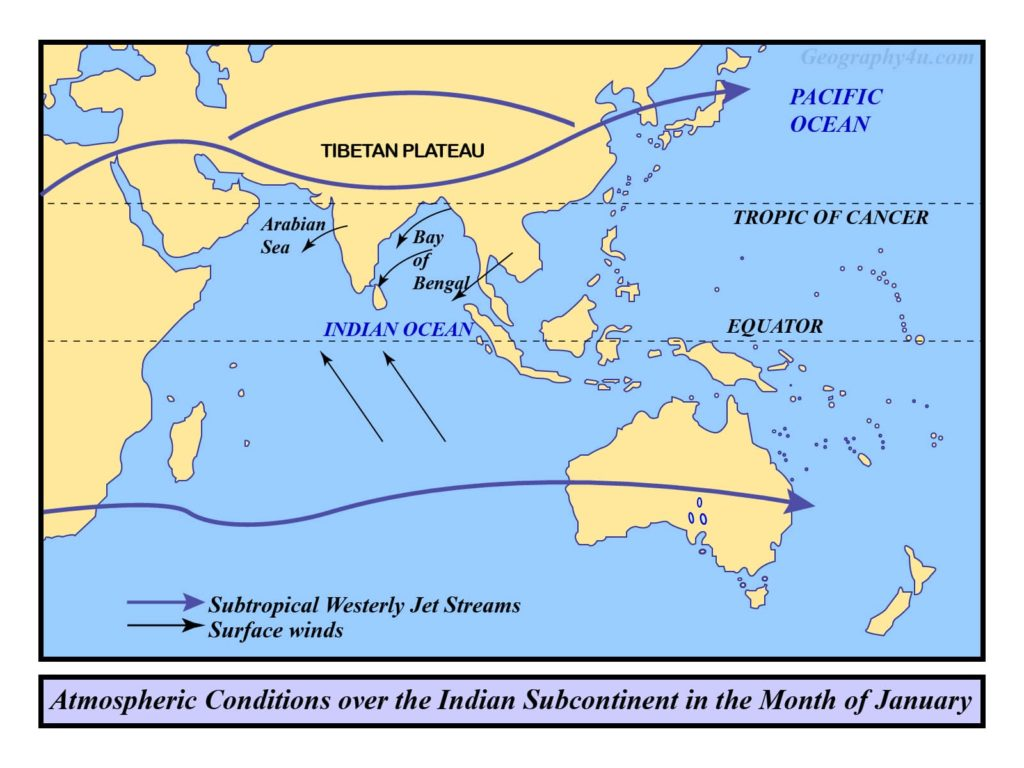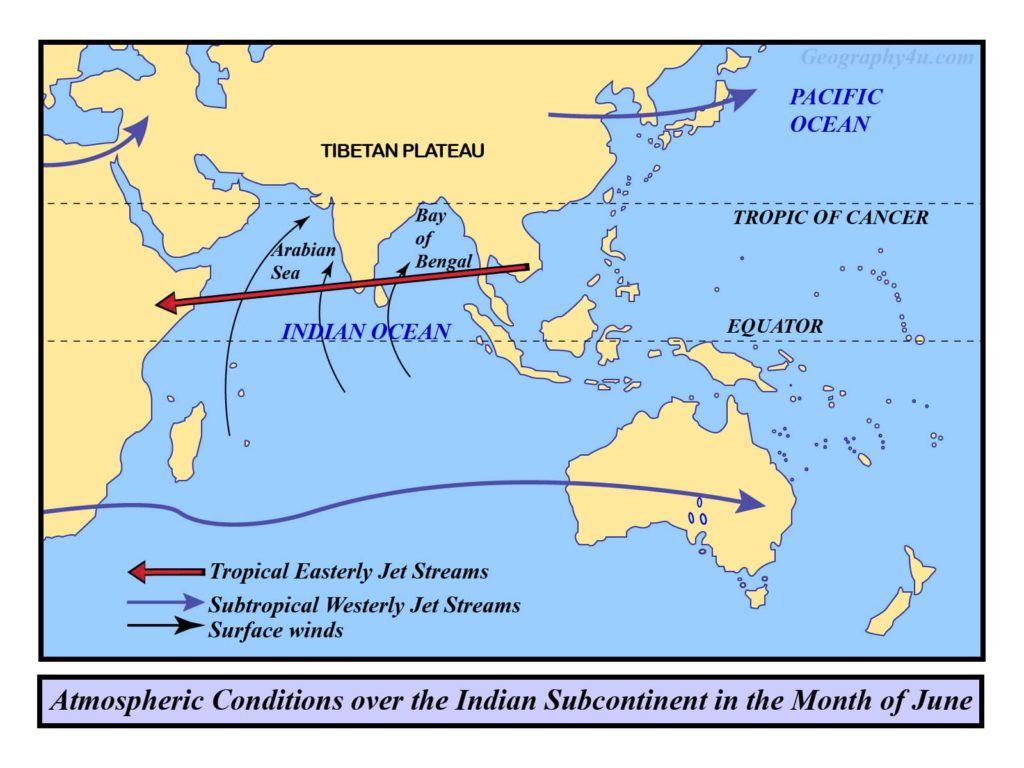- Filter By :
- Geography
- History
- Indian Heritage & Culture
- Indian Society
-
Q. Explain the role of subtropical westerly and tropical easterly jet streams in the onset and withdrawal of the Indian monsoon. (250 words)
30 Jun, 2025 GS Paper 1 GeographyApproach:
- Introduce the answer by briefing about Indian monsoon and role of subtropical westerly and tropical easterly jet streams
- Give role of Subtropical Westerly Jet Stream (STWJ) and Tropical Easterly Jet Stream (TEJ) in e onset and withdrawal of the Indian monsoon.
- Conclude suitably.
Introduction
The Indian monsoon is a seasonally reversing wind system primarily driven by differential heating between land and ocean, with critical modulation by upper-tropospheric jet streams.
- Among them, the Subtropical Westerly Jet Stream (STWJ) and the Tropical Easterly Jet Stream (TEJ) play a pivotal role in determining the timing, strength, and spatial distribution of the onset and withdrawal of the Indian summer monsoon (ISM).
Body:
Role of Subtropical Westerly Jet Stream (STWJ):
- A high-velocity westerly wind belt, active in winter and spring months. Found at latitudes of 25°–35° N, approximately 200 hPa (12–14 km) altitude.
- Associated with upper-level divergence, cold air advection, and western disturbances.
- Role in Monsoon Onset
- Winter Dominance Suppresses Monsoon Formation
- During winter and early summer, STWJ lies over the Indian subcontinent, contributing to cool and dry weather.
- Its presence aloft suppresses vertical convection, thereby inhibiting pre-monsoon rainfall.
- Northward Shift is a Trigger for Onset
- By late May or early June, due to intense heating of the subcontinent and Tibetan Plateau, the STWJ shifts northward into the mid-latitudes.
- This vacates upper-air space, enabling ascent of moist air and low-pressure formation at the surface.
- Enhances Tropical Convective Activity
- Its withdrawal allows ITCZ (Inter-Tropical Convergence Zone) to move northward, aligning over the Indian landmass.
- This leads to the burst of the monsoon, beginning typically over the Kerala coast.
- Winter Dominance Suppresses Monsoon Formation
- Role in Monsoon Withdrawal
- Southward Re-establishment
- In September–October, with cooling of the landmass, STWJ shifts southward, reinstating stable, dry upper-level air over the subcontinent.
- Promotes Drying and Stability
- The re-entry of STWJ suppresses convection and marks the transition from southwest monsoon to northeast monsoon (especially over Tamil Nadu).
- Southward Re-establishment
Role of Tropical Easterly Jet Stream (TEJ):
- Strong easterly winds peaking during June to August. Located between 5°–20° N, at altitudes of 100–150 hPa (6-9km).
- Originates due to strong thermal gradients between the equatorial Indian Ocean and the heated Tibetan Plateau (forming the Tibetan High).
- Role in Monsoon Onset
- Formation of Upper-Level Easterlies
- The TEJ sets in after STWJ’s northward shift, usually by late May.
- It reflects the establishment of a warm-core upper-level high over Tibet, a prerequisite for monsoon onset.
- Supports Deep Convection
- TEJ induces upper-level divergence, encouraging ascent of moist air from the Arabian Sea and Bay of Bengal.
- Promotes vigorous convective rainfall across the Indian subcontinent.
- Strengthens Monsoonal Circulation
- TEJ enhances vertical wind shear, which is favorable for organized monsoon activity and widespread rainfall.
- Onset Confirmation Parameter
- The India Meteorological Department (IMD) uses TEJ strength and positioning as a parameter to confirm monsoon onset.
- Formation of Upper-Level Easterlies
- Role in Monsoon Withdrawal
- Gradual Weakening in September
- As surface heating declines, the thermal contrast over the Tibetan Plateau weakens, leading to the disintegration of TEJ.
- Collapse of Monsoonal Vertical Support
- The disappearance of upper-level divergence results in weakened convection and a gradual drying of the atmosphere.
- Withdrawal from Northwest to Southeast
- TEJ’s weakening facilitates the organized retreat of monsoon from northwest India first, progressing toward the southern peninsula.
- Gradual Weakening in September
Conclusion:
The Subtropical Westerly Jet and the Tropical Easterly Jet form a dynamic upper-atmospheric framework that governs the onset, intensity, and withdrawal of the Indian monsoon. Their inverse movement (STWJ retreats as TEJ strengthens) is a classic feature of monsoon dynamics.
To get PDF version, Please click on "Print PDF" button.
Print PDF






